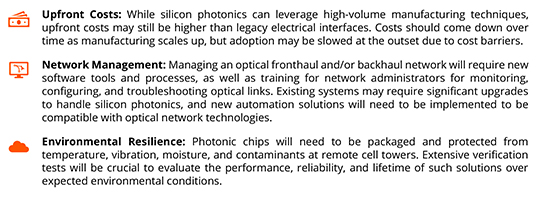By Larbi Belkhit | 4Q 2023 | IN-7106
Registered users can unlock up to five pieces of premium content each month.
Silicon Photonics for 5G |
NEWS |
Silicon photonics brings the advantages of optical communications to miniaturized photonic chips. It relies on the fabrication of components such as waveguides, modulators, and emitters using existing semiconductor manufacturing techniques. Light waves can encode and deliver data significantly farther and faster than copper, and glass fiber can transmit multiple light waves simultaneously—a key benefit compared to using electronic signals. Silicon photonics leverages existing fiber infrastructure and aims to bring the benefits of optical communication closer to the edge.
As 5G expands, the demand for greater wireless bandwidth, lower latency, and higher capacity continues to grow. As networks become more virtualized, the threat of electromagnetic attacks and side channel attacks measuring emitted electromagnetic radiation grows. While this form of cyberattack is currently theoretical and future looking, ensuring that hackers are unable to disrupt network activity is integral to the reputation of vendors in the telecommunications industry. Optical fiber is already used in the fronthaul as many operators prefer it over copper where available. This is why Carrier Ethernet and the Enhanced Common Public Radio Interface (eCPRI) are being used; however, optical fiber remains external to the radio units in the telco industry.
With Open Radio Access Network (RAN) vendors continually working on improving their available solutions to increase adoption in the market, various technologies are being developed and assessed for future commercial deployment, with Vodafone recently announcing its investigation of silicon photonic chips in its Research and Development (R&D) center in Malaga, in collaboration with Salience Labs and iPronics. Vodafone aims to assess whether silicon photonics has the potential to process and deliver huge amounts of data faster, but still securely. Salience Labs is building solutions to overcome the challenges posed due to the rate of growth in Artificial Intelligence (AI). iPronics’ work on Radio Frequency (RF) beamforming ensures all aspects of a base station are covered. Vodafone expects the photonic chips to sit at the heart of its mobile base stations.
The Benefits and Challenges of Silicon Photonics for Open RAN |
IMPACT |
Vodafone’s interest in assessing the capabilities of silicon photonics indicates the potential of such a technology for 5G network solutions. Integration of this technology into Open RAN solutions has the potential for significant benefits for future solutions:

However, a number of hurdles must be overcome through R&D for silicon photonics to become a viable technology for Open RAN solutions:

How Can the Industry Integrate Silicon Photonics? |
RECOMMENDATIONS |
Overall, the benefits of silicon photonics are compelling, but there are real technology and ecosystem challenges associated with its widespread deployment throughout Open RAN networks. ABI Research recommends that vendors, operators, and chipset vendors collaborate and contribute to O-RAN Alliance activities related to this development in the future and follow these approaches:
- Ecosystem Collaboration: Bringing together the radio, optical networking, and semiconductor industries is important to ensure silicon photonics innovations are tailored to and integrated into Open RAN deployments. Smooth integration of any new technology is dependent on strong coordination between vendors and operator customers during each phase from design to field deployment, as has happened with Graphics Processing Unit (GPU) technology for 5G networks. RAN vendors must work closely with silicon photonic chip suppliers to ensure built modules seamlessly connect photonic chips with their solutions.
- Introducing More Vendors: Currently, only a handful of silicon photonics vendors provide suitable solutions for Open RAN use cases. Having a diverse set of suppliers prevents the industry from relying on any single vendor’s technology, ensuring that the O-RAN Alliance goal of vendor interoperability is met. Furthermore, increased competition further drives innovation and cost reduction for this technology, leading to accelerated adoption in the market.
Silicon photonics for Open RAN is only just in the R&D phase of development. As the entire 5G industry continues maturing and developing, especially with regard to integrating AI models, the advancement of chipsets remains an extremely important area of focus to support all new technologies for networks. Silicon photonics can definitely assist in the network virtualization that Open RAN strives for, but extensive research is required before Proofs of Concept (PoCs) can be developed. The announcement of successful PoCs can be expected in the medium term at the earliest, but a commercial deployment will still be a long way away. It will take time to prove the viability of such technology, but its potential will definitely entice others to assess it for themselves.